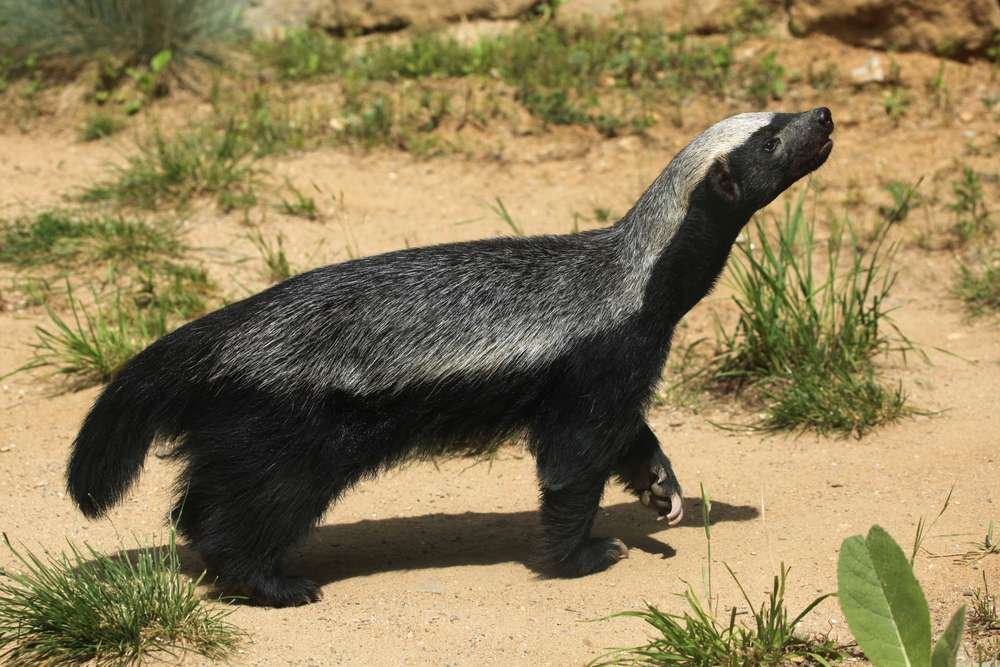Cape Honey Badger
( Chiwuli (Namwanga), Cape ratel or Southern African ratel )
- Mellivora capensis capensis
- IUCN Status: Least Concern
- Trend: decreasing

- Kingdom: Animalia
- Phylum: Chordata
- Class: Mammalia
- Order: Carnivora
- Family: Mustelidae
- Subfamily: Mellivorinae
- Genus: Mellivora
Share:
General Information
Honey badgers are carnivorous mammals, classified in the family Mustelidae. They travel singly or in pairs. The young, usually two, are born in burrows.
Fun Facts
The cape ratel or cape honey badger gets its name from its common collaboration with the honeyguide bird (Pulupulu in Namwanga), in obtaining honey which is their favorite food. The bird searches for a bee colony, and when one is found, the honey badger rips it open. The bird and the honey badger then share the honey.
Description
It has a fairly long body, but is distinctly thick-set and broad across the back. Its skin is remarkably loose, and allows the animal to turn and twist freely within it. The skin around the neck is 6 mm thick which is an adaptation to fighting. The head is small and flat, with a short muzzle. The eyes are small, and the ears are little more than ridges on the skin, another possible adaptation to avoiding damage while fighting. It has short and sturdy legs, with five toes on each foot. The feet are armed with very strong claws, which are short on the hind legs and remarkably long on the forelimbs. The tail is short and is covered in long hairs, save for below the base.- Shoulder height: 23 to 28 cm
- Length: 55–77 cm
- Weight: 5 to 16 kg
Ecology & Behaviour
he honey badger is mostly solitary, but has also been sighted in Africa to hunt in pairs during the breeding season in May. It also uses old burrows of aardvark, warthog and termite mounds. It is a skilled digger, able to dig tunnels into hard ground in 10 minutes. The honey badger is notorious for its strength, ferocity and toughness. It is known to savagely and fearlessly attack almost any other species when escape is impossible, reportedly even repelling much larger predators such as lion and hyena. Bee stings, porcupine quills, and animal bites rarely penetrate their skin. If horses, cattle, or Cape buffalos intrude upon a honey badger’s burrow, it will attack them.
The honey badger has a very wide and unspecialised diet. They raid beehives in search of both bee larvae and honey, they also feed on insects, frogs, tortoises, turtles, lizards, rodents, snakes, birds, eggs, berries, roots, bulbs. When foraging for vegetables, it lifts stones or tears bark from trees. Some individuals have even been observed to chase away lion cubs from kills. It devours all parts of its prey, including skin, hair, feathers, flesh and bones, holding its food down with its forepaws. It feeds on a wide range of vertebrates and seems to subsist primarily on small vertebrates.
Conservation
It is listed as “Least Concern” on the IUCN Red List.
Distribution & Habitat
Honey badgers are widespread across africa, the middle east and asia and have several subspecies worldwide.
Interaction with Humans
They have long been considered a pest to humans especially farmers for killing large numbers of poultry. Because of their strength and persistence, they are difficult to deter. They are known to rip thick planks from hen-houses or burrow underneath stone foundations. Because of the toughness and looseness of their skin, honey badgers are very difficult to kill with dogs. Their skin is hard to penetrate, and its looseness allows them to twist and turn on their attackers when held. The only safe grip on a honey badger is on the back of the neck. The skin is also tough enough to resist several machete blows. The only sure way of killing them quickly is through a blow to the skull with a club or a shot to the head with a gun, as their skin is almost impervious to arrows and spears. During the British occupation of Basra in 2007, rumours of “man-eating badgers” spread which of course were denied by the British military and have never been proven 😀
No donation to this project yet.
| M | T | W | T | F | S | S |
|---|---|---|---|---|---|---|
| 1 | 2 | 3 | 4 | 5 | 6 | |
| 7 | 8 | 9 | 10 | 11 | 12 | 13 |
| 14 | 15 | 16 | 17 | 18 | 19 | 20 |
| 21 | 22 | 23 | 24 | 25 | 26 | 27 |
| 28 | 29 | 30 | 31 | |||


